
In the course of my several voyages, I never before met with the natives of any place so much astonished as these people were upon entering a ship. Their eyes were continuing flying from object to object; the wildness of their looks and gestures fully expressing their entire ignorance about everything they saw, and strongly marking to us, that till now they had never been visited by Europeans, or been acquainted with any of our commodities except iron, which, however, it was plain they had only heard of, or had known it in some small quantity brought to them at some distant period… Plates of earthenware, china cups, and other such things, were so new to them that they asked if they were made of wood; but wished to have some that they might carry them to be looked at on shore. They were in some respects naturally well bred; or at least fearful of giving offence, asking where they should sit down, whether they might spit upon the deck, and the like.
[From a report of the third voyage of exploration headed by Captain James Cook to Hawai'i].
Out of context, it is difficult from the quote above to clearly discern which party is actually doing the exploring. Polynesians had been sailing on the open sea perhaps as early as the time of Jesus Christ. Europeans, until Christopher Columbus, and Asians even later, had always sailed within sight of coastlines. So to say Captain James Cook, who commanded the ships, the Discovery and the Resolution, "discovered" the Hawaiian Islands on his third voyage of exploration in 1778 is not quite accurate. After all, the islands were inhabited by people who had discovered them hundreds if not more than a
thousand years earlier. If the need to explore was based on the need to fill some discontent, the early Hawaiians were probably more content even if their material goods were less complex, if not as rich, than the goods of the Europeans who came looking for them.
Cook named the island group the Sandwich Islands after his sponsor, the First Lord of the Admiralty, the Earl of Sandwich. The records of Cook's third voyage along with the reports of two subsequent British explorers, Captain George Vancouver (1792, 1793 and 1794) and Archibald Campbell (1809), and a Russian expedition led by Lieutenant Otto Von Kotzebue (1816 and 1817) provide perhaps the best early observations of the Native Hawaiian people. Cook had already visited Tahiti and had a Tahitian on board, but purportedly found the Islands by following the path of land birds and large sea turtles. One of the first things he had learned upon finding out the islands were inhabited was that the natives spoke a language similar to Tahitian. In fact, Hawaiians and Tahitians share an estimated 85 percent of their basic vocabulary, according to Anthropologist Dorothy Barrère. The written form of Hawaiian that is in use today, however, was not developed until the 1820s--Hawaiian was a spoken language in which traditions were recorded in mele (songs or chants), so earlier written accounts use strange spellings for words that are common to us today, including at times r, t and v which appear in Tahitian, but were omitted and replaced with l, k and w in the system later standardized by Protestant missionaries.
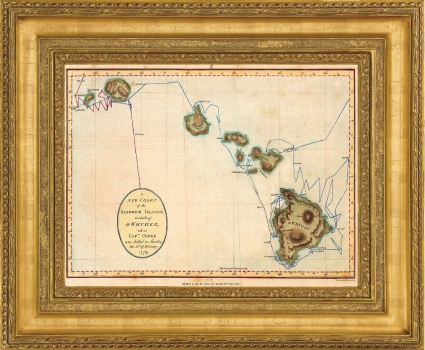
Hula, for example, was usually spelled "hura", Hawai'i was Owhyhee, Kamehameha was Tamaahmaah. Other examples include Honolulu for Hana-rura or Hannah-rourah, Kaui for Attowai, Maui for Mowee, Niihau for Onehow, O'ahu for Woahoo, and Waikiki for Whyteete. Consequently, I have substituted the original spellings of words from these accounts with modern spellings below, even in quotations.
The early Hawaiians clearly saw the European vessels as large, floating treasure chests. Cook bragged that "several small pigs were got for a sixpeny nail or two apiece." But the Hawaiians were not simply satisfied with trading for what they wanted from these new, foreign people:
Some of their most expert swimmers were one day discovered underneath our ships, drawing out the filling nails of the sheathing, which they performed very dexterously by means of a short stick, with a flint stone fixed in the end of it. To put a stop to this practice, which endangered the very existence of the vessels, we at first fired small-shot at the offenders; but they easily got out of our reach by diving under the ship's bottom. It was therefore found necessary to make an example, by flogging one of them on board the Discovery.
On another occasion, a native had stolen a boat's rudder from one of the ships: "I thought this a good opportunity to show these people the use of fire-arms," wrote Cook, "and two or three muskets and as many four-pounders, were fired over the canoe which carried the rudder. As it was not intended that any shot should take effect, the surrounding multitude of natives seemed rather more surprised than frightened." These exchanges did not always end without injury, and the murder of a chief on another occasion is thought by many to have precipitated the incident which ended in Cook himself being killed in the Sandwich Islands.
Cook had seen tattooing in the South Pacific before arriving in the Sandwich Islands, but
what he noticed was unique about Hawaiians was that they had facial tattoos, as only in
New Zealand, and rather than spirals that were found in the latter's tattoos:
[The designs were] in straight lines, crossing each other at right angles. The hands and arms of men are also neatly marked, and they have a singular custom amongst them, the meaning of which we could never learn, that of tattowing the tips of the tongues of the women. From some information we received, relative to the custom of tattowing, we were inclined to think that it is frequently intended as a sign of mourning on the death of a chief, or any other calamitous event… The lowest of the class is often tattowed with a mark that distinguishes them as property of the several chiefs to whom
they belong.note
It was later confirmed that the tattoos on women's tongues were memorials to the dead as learned by Lord Byron in a visit on the Blonde (see below)
Captain George Vancouver, who had served under Cook as a midshipman on the Resolution during Cook's second voyage as well as on the Discovery during the third voyage, explored the Sandwich Islands during the winters of 1792, 1793 and 1794. Here he describes how the Hawaiians dressed:
These people are scanty in their cloathing, very few of the Men [kane] wear any thing more than the malo (a loin cloth), but the women [wahine] have a piece of cloth [a pa'u made from kapa or bark cloth] wraped round the waist, so as to hang down like a petticoat as low as the knee; all the rest of the body is naked. Their ornaments are bracelets, necklaces and Amulets, which are made of shells, bone [typically dog teeth for an anklet or boar tusks for bracelets] or stone; They have also neat Tippets [ahu'ula or cloak] made of red and yellow feathers,.. and Cloakes covered with the same or some other feathers; the cloakes, reach to about the middle of the back, and are like the short cloakes worn by the women in England, or like the riding cloakes worn in Spain.
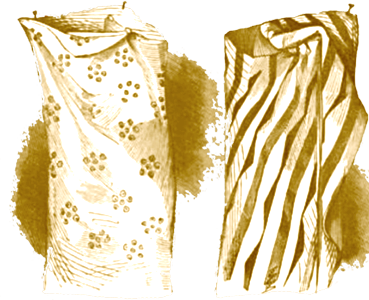 pa'u |
 boar-tusk bracelet |
Archibald Campbell, who explored the Sandwich Islands in 1809, provides this detailed explanation of the composition of the cloth used for women's pa'u:
The cloth called kapa is entirely manufactured by women, and is made from the bark of a tree, which is first steeped in water, and then beat out with a piece of wood, grooved or furrowed like a crimping machine. The bark is laid upon a piece of wood, grooved like the former. As these two instruments are at right angles during the operation, the marks in the cloth are crossed like warp and woof... It is colored with the juice of berries, laid on with a piece of tortoise shell, shaped like a knife, or with a brush, formed by chewing the end of a slip of bamboo. In this manner it is tinged brown, blue, green or black; to produce a yellow, the cloth is dipt in a dye prepared by boiling the cone of a tree in water. They often paint a variety of patterns, in which they display great taste and fancy... This cloth, from its texture, is, when wetted, extremely apt to get damaged, in which state it tears like moist paper; great care, therefore, is always taken to keep it dry, or to have it carefully dried when it is wetted; when they swim off to ships, they hold their clothes out of water in one hand, occasionally changing it as it becomes fatigued.
Cook noted that Hawaiian women also wore a malo "that is thin, much resembling oil-cloth; and which is actually either oiled or soaked in some kind of varnish, and seems to resist the action of water pretty well.”
 mushroom mahiole |
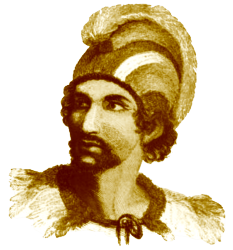 mahiole |
The men sometimes wore mahiole (helmets) covered with feathers similar to those used for the ahu'ula, or cloaks, which were made "so as to fit very close to the head with a semicircular protuberance on the crown exactly like the helmets of old." (Vancouver) These mahiole had "a strong lining of wicker work, capable of breaking the blow of any warlike instrument, and seems designed for that purpose." (Cook)
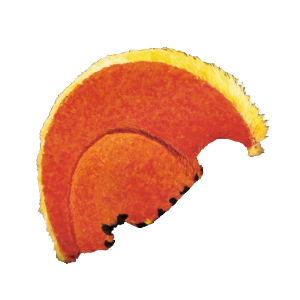 mahiole |
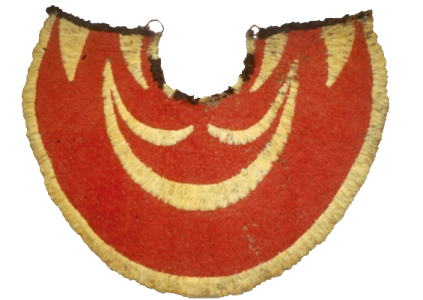 ahu'ula |
Women often wore vine wreaths on their head with flowers strung on them. “They prefer purple, yellow and white, and arrange them alternately three or four inches of colour. This is twined several times around the head, and has a very elegant appearance." (Vancouver)
“Some of the men had a kind of wig made of human hair twisted together into a number of long tails,” commented Vancouver, “each a finger thick that hung down as low as the
breach. Some of the men had long beards but the general custom was to have it short."
More than two decades later, after foreign vessels had regularly been wintering in the Islands, commentators from the Russian expedition on the brig Rurick reported:
The men shave their beards, and cut their hair in the form of a helmet, the crest of which is often bleached, so as to be of a light or whitish colour. The women have it cut short, keeping only a rim over the forehead, bleached white with unslacked lime, and standing up like bristles. Sometimes a fine long curl is preserved on the middle of the forehead, and dyed violet, which is combed back.
Vancouver admired Hawaiian salt production which was done in large quantities because it was "equal in colour and in quality to any made in Europe, but the crystals are much larger."
While Campbell said that "all ranks" of natives "pay the utmost attention to cleanliness," Cook provide a more general account of their health after cataloguing several different deformities due to birth or injuries he had observed, some of which were blamed on heavy consumption of salt or kava, an herb:
Squinting is also very common amongst them… They are, in general, very subject to boils and ulcers which we attributed to the great quantity of salt they eat with their flesh and fish.... Many of them suffer still more dreadful effects from the immoderate use of 'awa [kava]. Those who were the most affected by it had their bodies covered with a white scurf, their eyes red and inflamed, their limbs emaciated, the whole frame trembling and paralytic, accompanied with a disability to raise the head.
Lieutenant Otto Von Kotzebue added this observation about the use of 'awa:
I took a walk every evening when the air was cooled. This may be done here without any fear of attack, for though one frequently meets with drunken people, they are in this state the most cheerful and affectionate. They intoxicate themselves with the 'awa-root, which is prepared in the same manner as in the other South-Sea islands, with this exception, that here only the old women chew the root, and the young ones only spit into the dish to dilute the pap.
Archibald Menzies, a "naturalist" whose notes come to us from the Vancouver exploration, hinted at the free sexual spirit of the common Native Hawaiian: "whoever might be inclined to censure the conduct of the" Native Hawaiian "ladies for with-holding their company from us on the preceding day, had now no cause to complain for they came off in large groups not only in the Canoes but on swimming boards with no other intention than that of tendering their persons to any one that would choose to have them [casual sexual liaisons were referred to as moekolohe], & those who were unsuccessful in their aim went away chiding us for our want of gallantry."
Earlier, Cook had recorded his concerns during his first voyage to the Sandwich Islands that his men might spread venereal diseases amongst the native women:
The opportunities and inducement to an intercourse between the sexes are then too numerous to be guarded against; however confident we may be of the health of our men, we are often undeceived too late. It is even a matter of doubt with me, if it be always in the power of the most skilful of the faculty to pronounce, with any certainty, whether a person who has been under their care, in certain stages of this malady, is so effectually cured as to leave no possibility of his being still capable of communicating the taint. It is likewise well known, that amongst a number of men. There are generally to be found some so bashful as to endeavor to conceal their labouring under any symptoms of this disorder. And there are others again, so profligate as not to care to whom they communicate it. Of this last we had an instance at Tongatapu [Tonga]…who had been stationed to manage the trade… After he knew that he had contracted this disease, he continued to have connexions with different women, who were supposed not to have already contracted it. His companions expostulated to him without effect, tell Captain Clerke, hearing of this dangerous irregularity of conduct, ordered him on board.
Upon returning to the island, Cook found his worries had come true:
Women were also forbidden to be admitted to the ships, except under certain restrictions. But the evil I meant to prevent, by this regulation, I soon found, had already got amongst them… Some canoes coming off to us, I brought to. As soon as they got alongside, many of the people who conducted them got into the ship, without the least hesitation… These people had got amongst them the venereal distemper.
Kotzebue imposed a more strict discipline amongst his sailors, at least at times. During his first visit to the Sandwich Islands in 1816 while at Hawai'i, he stated: "Several canoes, filled with girls, rowed up to us; but as I had not time to show the politeness due the fair sex, I sailed quickly on." And a week later at O'ahu:
We had scarcely cast anchor when a great number of native women surrounded the Rurick, some in boats, and others swimming; they all wanted to come on
board, and were angry at being refused admittance. I had declared the ship kapu [meaning no Native Hawaiians were admitted] for some days, to be able to do do some necessary work. The amiable nymphs sang to us some love-songs, and turned back much astonished at our cruelty.
A naturalist from the Russian expedition, Adelbert von Chamisso, had an informant on O'ahu, a Spaniard named Don Francisco Pablo Marin. Marin was himself a naturalist who had imported several varieties of flora and fauna to the Sandwich Islands which he raised on a plantation and in the wild. He told Chamisso about the Hawaiian caste system which reveals the limits of sexual freedoms:
M. Marin assumes four casts in Hawai'i. The princes, the nobility, the middling class (who constitute the great majority of the people) and the populace, a despised class, which is not numerous.
... It is to be understood, that the casts are so determined, that it is not possible to go from one to the other. Nobility which can be given and taken away is none. The woman does not share the rank of the husband. The rank of the children is determined by very fixed and certain laws, chiefly after that of the mother, but also after that of the father. A noblewoman who marries a man of the lower class loses her rank as soon as she has children, in which case she and her children descend to the cast of her husband.
 Temple on the Island of Hawai'i, by Louis Choris from the Russian expedition aboard the Rurick |
This caste system, no doubt, fostered incestuous relationships amongst the leading ali'i (or ruling elite). Charles Samuel Steward, a missionary in the Kingdom of Hawaii from 1822-25, discovered, Keopuolani, for example, was, at once , the cousin, niece, and wife of Kamehameha; and Kaumuali'i, the king of Kaui, and his son, Keali'iahonui, are both, at present, the husbands of Ka'ahumanu. Kap'iolani also has two husbands."
Amongst the ali'i, religious life centered around the heiau, or temples. Kotzebue observed several heiau on the island of Hawai'i, "which belong to the chiefs of these parts, and may be recognized by the stone fence, and the idols placed in them." Chamisso, who was invited to go to one on O'ahu by the principal chief at Honolulu, Kalanimoku or Karimoku, noted that the breaking of kapu of the heiau would lead to certain death, yet he was surprised: "We expected a certain seriousness during the sacrifices and prayers; and were astonished at the profane disposition which manifested itself; the indecorous sport that was made with the idols; and the tricks which they delighted to play us during the sacred ceremony. Children show more sedateness in playing with their dolls." Kotzebue shared this uncharacteristically condescending viewpoint of Native practices at the heiau where he found: "the sight of the idols laughable," but "did not let the islanders perceive it, that I might not offend them; but I was the more astonished when the priests themselves made me observe the caricatures, felt their eyes and noses, tried to imitate, in various ways, the distorted faces, and laughed heartily at their wit."
It is generally difficult to assess observations in isolation, though when we have consistent patterns of observations over several visits, or a range of observations in one visit to the Sandwich Islands we can rest more comfortably in the reliability of observed practices unprejudiced, or at least the prejudices are easier to strip away in our detached assessment, by foreign perspectives that attach a certain meaning to a specific type of decorum and discipline. So while we hear of priests being what we might view as sacrilegious, we might temper that belief with another observation by Kotzebue which provides an extended, if not more well-rounded understanding of Early Hawaiian humor noted in earlier comments. Eight double canoes led by John Young (see below) and manned by Hawaiians were coming towards the Rurick at Honolulu to help transport the crew to land. "The scene on board the boats was very entertaining; they laughed and joked, and even their work was done as if in play, and the islanders appeared like sportive children." Certainly the Early Hawaiians were entitled as anybody to have a unique sense of humor without being characterized for it as being childlike.
Still Chamisso was broad enough in his perspective of Hawaiian life to argue: "Human sacrifices, it is true, still take place, but it would be unjust to upbraid the Hawaiians for them. They sacrifice culprits to their gods, as we sacrifice them in Europe to justice." Kapu, was actually a term for social sanctions imposed both by Hawaiian religion and the high chiefs. Some kapu were imposed specifically on women, who Cook explained “are not only deprived of the privilege of eating with men, but the best sorts of food are kapu or forbidden them. They are not allowed to eat pork, turtle, several kinds of fish, and some species of the plantains.” Kotzebue said that because these meats were kapu for women, they ate fruit-fed dogs instead. Kapu extended to cooking and eating together so that besides having a hut to sleep in, each family had one for the men to eat in and one for the women. Chamisso shared the story of a body of a woman which was found floating around the Rurick. Drunk, she had apparently entered the hut where her husband was eating and consequently was killed for the transgression. Despite kapu, however, Chamisso found "that women, when they know they are unobserved, make no difficulty of transgressing the many prohibitions to which they are subject."
Kapu could be permanent interdictions as above or temporary ones, as when Vancouver explained that women who were not permitted to use canoes to go out to his ship simply swam; or connected to a specific holy day. Kapu could also involve spatial restrictions marked off with “tuft wands or kapu sticks” (Cook) just as Kotzebue made the Hawaiian women understand that the Rurick was kapu. In general however, kapu were merely restrictions, either religious or legal against Hawaiians and even foreigners.
Two of the most distinctive aspects of early Hawaiian culture, surfing and hula, have long since spread far beyond Hawai'i requiring a look at how they once existed. The water that surrounded the islands was an intrinsic part of early Hawaiian life as Vancouver relates here:
They are an open, candid, active people and the most expert swimmers we had met with; in which they are taught from their very birth: It was very common for women with infants at the breast to come off in Canoes to look at the Ships, and when the surf was so high that they could not land them in the Canoe they used to leap over board with the child in their arms and make their way a shore through a surf that looked dreadful.
As surfboards have become smaller and smaller over the last several decades, we are prone to think the early Hawaiians only surfed on extremely long boards, but this is not the case according to what Cook observed: a "float-board" is a "board a little longer than the human body, feathered at the edges, on which these Islanders stretch themselves and float for hours on the water, using their limbs as paddles to guide them, or at other times trusting to the impulse of the waves: the very children have their little boards." Surfing was apparently favored by young and old, ali'i and commoner. One of Vancouver's mates, Peter Puget, recorded this surfing scene he observed while walking on a small, stony beach in Kona with the chief Ke'eaumoku in 1794:
The natives were amusing themselves in the Surf on Swimming Boards. Namahana, the wife of Ke'eaumoku [the chief of Kona and father of Ka'ahumanu], who is reckoned one of the most expert at that Diversion immediately Stript naked and she certainly notwithstanding her Corpulency performed her part with wonderful Dexterity. The first Sea or Surf that brought her in towards the Beach was immensely high, on it Top she came, floating on a Broad Board till the Break[er] had nearly reached the Rocks, she then suddenly turned, went under that & the one following and so on till she regained her Situation at the back of the whole. Then she waited for a large Swell and once more performed her part with great Expertness."
Vancouver and his party attended a royal hula performance one afternoon where he conservatively estimated the audience numbered 4,000 people "of all ranks and descriptions of persons" including several female family members of the principal chiefs. Seven women performed, three of whom were ali'i, and they were accompanied by five males who provided percussion-musical accompaniment for the 4-part performance which last about an hour long. Vancouver was obviously impressed by most of the hula:
The variety of attitudes into which these women threw themselves, with the rapidity of their action, resembled no amusement in any other part of the world within my knowledge....
In each of the first [three] parts the songs, attitudes, and actions, appeared to me of greater variety than I had before noticed amongst the people of the great South Sea nations, on any former occasion.
But his reaction to the fourth part of the performance changed drastically:
Had the performance finished with the third act, we should have retired from their theatre with a much higher idea of the moral tendency of their drama, than was conveyed by the offensive, libidinous scene, exhibited by the ladies in the concluding part. The language of the song, no doubt, corresponded with obscenity of their actions; which were carried to a degree of extravagance that was calculated to produce nothing but disgust even in the most licentious.
It is difficult to imagine what could have shocked this man who had also spoken so frankly about his men spreading venereal disease to the Hawaiians, but, unfortunately, we have no more details.
[The aim of these historical observations was to provide an introduction to a people and a way of life through the lense of those who first encountered them from outside and is necessarily limited. A more thorough explanation of early Hawaiian material culture can be found in an impressively detailed volume, Arts and Crafts of Hawaii by Te Rangi Hiroa (Peter H. Buck), Honolulu: Bishop Museum Press, 1957.]
Having given a brief introduction to the early Hawaiians, we now shift focus to four individuals, Kamehameha, Ka'ahumanu, Isaac Davis and John Young, who helped shape Hawai'i during the turn of the eighteen century and laid the foundation for what was to come. During Cook's visit to the Sandwich Islands from 1778-1780, Kamehameha was not yet a chief and the Sandwich Islands were ruled by disparate chiefs. Twelve years later, through Vancouver's three trips to the Sandwich Islands, various chiefs still shared rule of the islands, but Kamehameha was chief of the northern half of the Big Island, Hawai'i, and was actively engaged in spreading his rule, in part through the use of acquired foreign advice, ships, and weapons. By 1809 when Campbell came to the Sandwich Islands, Kamehameha was all but finished unifying them under his rule.
Cook's lieutenant described Kamehameha in 1779 as having "as savage a looking face as ever I saw, it however by no means seemed an emblem of his disposition, which was good natured & humorous." Vancouver's evaluation of Kamehameha seems always in relation to how he interacted with others. During one of the voyages, Kamehameha and one of his wives, Ka'ahumanu, were having a quarrel because Kamehameha felt she was seeing another man. After their reconciliation, Vancouver wrote in February 1793:
She appeared about sixteen [she was actually closer to 20], and undoubtedly did credit to the choice and taste of Kamehameha [who was about 35], being one of the finest women we had yet seen on any of the islands. It was a pleasure to observe the kindness and fond attention, with which on all occasions they seemed to regard each other; and though this mode of behaviour in public would be considered as extravagant in the polished circles of society, yet to us, so far removed from the civilized world, the profusion of tenderness was very admissible, and could not be regarded without a warmth of satisfaction at thus witnessing the happiness of our fellow creatures.
Commander of the British slope Providence, William Robert Broughton, encountered Kamehmeha in the midst of his conquest in January 1796: In the morning, he paid us a visit, attended by all his chiefs, dressed for the occasion in cloaks [ahu'ula] and helmet caps [mahiole]. He himself wore European clothes, with a beautiful cloak composed of yellow feathers, which nearly covered him."
Several merchant ships had wintered and provisioned in the Sandwich Islands between Cook's discovery and Vancouver's voyages a dozen years later. American fur trader Simon Metcalfe was onboard one of his vessels, the Eleanora, and planning to meet up with another of his vessels, the Fair American, in Hawai'i before moving on to trade in China. A Hawaiian chief, however, had seized the Fair American (presumably with Kamehameha's foreknowledge), killing six men on board, including Metcalf's son. Welsh-born Isaac Davis was the only survivor. Kamehameha provided protection to Davis but would not let him leave the island fearing initially that he would tell Metcalf or other foreigners of the incident.
English-born boatswain, John Young, meanwhile, went to shore from the Eleanora to capture some wild boar on the island. When he reached land, he was held captive because Kamehameha didn't want him either to spread news of what had happened to the Fair American and its crew. Later, Kamehameha told Davis and Young that if either left the island, the other would be killed. In this way he held them hostage for three years as advisers, particularly on foreign military hardware and munitions. He rewarded them for their technical expertise with land and prestige. Vancouver, who was told the story of their lives on Hawai'i, offered to take them to America in 1794--for though they were both born in Britain, they were Americans--but they declined the offer:
After mature consideration, they preferred their present way of life, and were desirous of continuing at Hawai'i; observing, that being destitute of resources, on their return home, (which, however, they spoke of in a way that did honor to their hearts and understandings) they must be again exposed to the vicissitudes of life of hard labour, for the purpose of merely acquiring a precarious supply of the most common necessaries of life; ...for, besides the high reputation, and universal good opinion they had acquired amongst all classes of the inhabitants, they were now considered in the light of chiefs, and each of them possessed a considerable landed property. Here they lived happily, and in the greatest plenty.
Campbell, Kotzebue and Chamisso offer some of the most detailed observations of Kamehameha when he was at his height of power. During Campbell's visit in 1809, Kamehameha was living in Honolulu where foreign sailors had discovered a deepwater
port:
The village of Honolulu, which consisted of several hundred houses, is well shaded with large cocoa-nut trees. The king's residence, built close upon the shore, and surrounded by a palisade on the land side, was distinguished by the British colours and a battery of sixteen carriage guns, belonging to his ship the Lilly Bird, which at this time lay unrigged in the harbour.
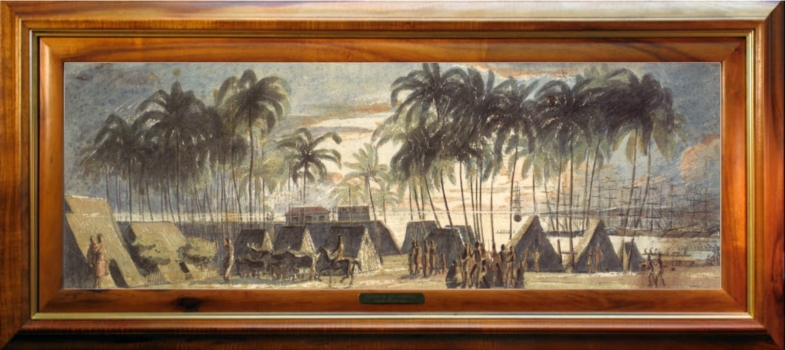 View of Honolulu in 1816 by Louis Choris |
.... His principal chiefs always being about his person, there were generally twenty or thirty persons present; after being seated upon mats, spread on the floor, at dinner, a dish of poi, or kalo [taro] pudding, was set before each of them, which they ate with their fingers, instead of spoons. This fair, with salt fish and consecrated pork from the heiau, formed the whole of the repast, no other food being permitted in the king's house. A plate, knife and fork, with boiled potatoes, were, however, always set down before Moxey and me, by his majesty's orders. He concluded his meal by drinking half a glass of rum, but the bottle was immediately sent away, the liquor being kapu, or interdicted for his guests.
... [Kamehameha is] about fifty years of age, he is
a stout, well-made man, rather darker in the complexion than the natives usually are, and wants two of his front teeth.* The expression of his countenance is agreeable, and he is mild and affable in his manners, and possesses great warmth of feeling; for I have seen him shed tears upon the departure of those to whom he was attached, and has the art of attaching others to himself. Although a conqueror, he is extremely popular amongst his subjects, and not without reason, for, since he attained the supreme power, they have enjoyed repose and prosperity. He has amassed a considerable treasure in dollars, and possesses a large stock of European articles of every description, in particular arms and ammunition; these he has acquired by trading with the ships that call at the islands. He understands perfectly well how to make a bargain; but is unjust accused of wishing to over-reach in his dealings. I never knew of his taking undue advantages; on the contrary, he is distinguished for upright and honorable conduct in all transactions. War, not commerce, seems to be his principal motive in forming so extensive a navy.
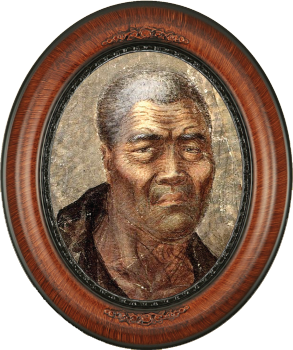 Kamehameha by Louis Choris |
.... He sometimes dressed himself in the European fashion, but more frequently laid aside his clothes, and gave them to an attendant, contenting himself with the maro. Another attendant carried a fan, made of feathers, for the purpose of brushing away flies; whilst a third carried his spit-box, which was set round with human teeth, and belonged, as I was told, to several of his predecessors.
* [On another occasion, Campbell had written that after Kamehameha's brother died, "the natives cut off their hair, and went about completely naked. Many of them, particularly the women, disfigured themselves, by knocking out their front teeth, and branding their faces with red hot stones, and the small end of calabashes, which they held burning to their faces tell a circular mark was produced; whilst, at the same time, a general, I may say, an universal, public prostitution of the women took place” Also in the journals of officers aboard the Blonde, which transported bodies of Kamehameha II and his favorite wife's back to the Kingdom of Hawai'i after they died in England, was written: the Native Hawaiians “have naturally fine teeth, but hitherto few men had grown up with a full set, it having been the fashion to extract a tooth or two to commemorate the death of a friend or chieftain. Our friend Boki [the governor of O'ahu] himself had four of his front teeth sacrificed to the Great Kamehameha; and the operation must have been severe: he was laid on his back, and his mouth filled with kapa, a sharp instrument was placed at the front of the teeth, and at one blow they were all knocked out at once!”]
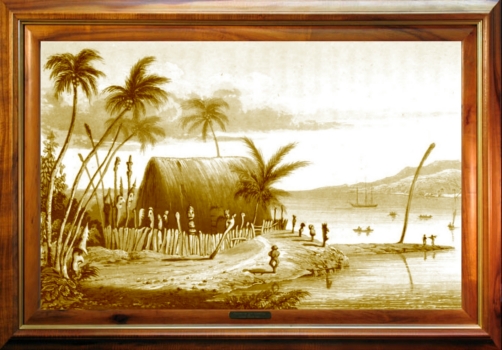 Pu'uohonua o Hoaunau, 1825 |
Kotzebue, who first met Kamehameha in 1816, arrived at an assessment of the King similar to Campbell's seven years earlier:
The view of the king's camp was concealed only by a narrow tongue of land, consisting of naked rocks, but when we had sailed round we were surprised at the sight of the beautiful landscape. We found ourselves in a small sandy bay of the smoothest water, protected against the waves of the sea; on the bank was a pleasant wood of palm trees, under whose shade were built several straw houses; to the right, between the green leaves of the banana-trees, peeped two snow-white houses, built of stone, after the European fashion, on which account this place has the mixed appearance of a European and Hawai'i village, which afforded us a new, but charming prospect; to the left, close to the water, on an artificial elevation, stood the heiau of the king, surrounded by large wooden statues of his gods, representing caricatures of the human figure... He conducted me to his straw palace, which, according to the custom of the country, consisted of one spacious apartment, and, like all the houses here, afforded a free draught both to the land and sea breezes, which alleviates the oppressive heat... Though the king has houses built of stone in the European fashion, he prefers this simple dwelling, not to forsake the customs of his country; he imitates every thing he knows to be useful, and tries to introduce it among his people; palaces built of stone appeared to him superfluous, as the straw houses are convenient, and as he only wishes to increase the happiness, and not the wants of his subjects.
Kamehameha provided Kotzebue and his officers with a meal in which: "he sometimes conversed with me, and then with his ministers, who could not refrain from laughing at his conceits." After the Russians finished, the King went for a walk to the
heiau where:
He embraced one of the statues, which was hung round more than the others, with fruits and pieces of a sacrificed hog, saying, "These are our gods, whom I worship; whether I do right or wrong, I do not know; but I follow my faith, which cannot be wicked, as it commands me never to do wrong... While the king is gone into the heiau, nobody is allowed to enter; and during that time we admired the Colossal idols, cut in wood, and representing the most hideous caricatures.
Afterwards, Kamehameha ate a meal himself, using his hands to do so. Knowing full well that Europeans and Americans did not eat with their hands, he turned to Kotzebue saying, "This is the custom in my country, and I will not depart from it!”
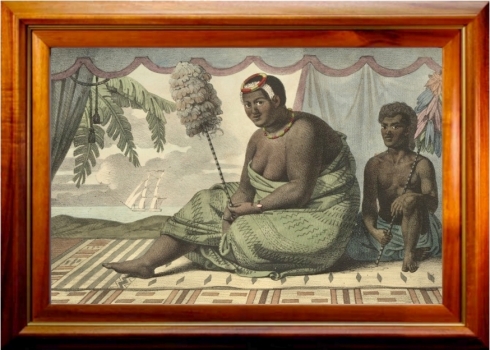 Ka'ahumanu by Choris |
When Kotzebue returned to the Sandwich Islands in 1817, Kamehameha was living back on Hawai'i, but off fishing when the Russians arrived at his home, so an interpreter took him to...:
[the King's] wives, who were sitting in the middle of a tent, on fine mats, under an umbrella of white sail cloth, refreshing themselves with water-melons. They were all three greatly rejoiced to see us again. I was obliged to sit next to Ka'ahumanu, who, after having put to us some indifferent questions, ordered water-melons to be brought, which were very cooling in the heat. Her politeness went so far, that she ordered a kanaka [the Russian explorers took this to mean servants, but it means more generally "person" or "people"] to drive away the flies from me, with a tuft of red feathers; she even cut out, herself, the middle of the melon, and put the piece into my mouth with her own royal hands; in doing which the royal nails, three inches long, incommoded me not a little.
When Kamehameha arrived later after fishing,
He did not give himself time to dress, but came naked up to me, and welcomed me with a cordial shake of the hand... His wardrobe was now fetched, which consisted of a shirt, a pair of old velveteen small-clothes, a red waistcoat, and a black neckcloth; and, without any ceremony, he dressed himself in my presence. His elegantly embroidered uniform he puts on only on very solemn occasions, and even then unwillingly... I observed, while he was dressing, many scars on his body, and, on my asking in what campaign he had received them, he answered, pointing to the N.E., "I have conquered these islands; and these scars prove that I deserve to be king of the whole group.”
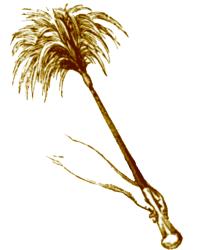 kahili pa'a lima (fly swatter) |
Isaac Davis and John Young were said to have been instrumental in Kamehameha's defeat of rival high chiefs of Maui, Molokai and O'ahu during his effort to unify the Sandwich Islands. When he left Hawai'i for O'ahu to be at Honolulu, where foreigners had discovered a port large enough for their ships, Kamehameha took Davis with him and named Young governor of Hawai'i. Campbell shares more details about Davis whom he spent time with at Honolulu:
Davis was married to a native woman, by whom he had no children. By a former wife he had three, two of whom were left under the charge of Mr. Young on Hawai'i. His house was distinguished from those of the natives only by the addition of a shed in front to keep off the sun; within, it was spread with mats, but had no furniture, except two benches to sit upon. He lived very much like the natives, and had acquired such a taste for poi, that he preferred it to any other food. He had, however, at all times abundance of pork, goat's flesh, and mutton, and frequently beef sent by Young from Hawai'i; and in the mornings and evenings we had tea. His wealth consisting of mats, feathers, and cloth, the produce of the island, and a large assortment of European articles, which he had acquired by trading with the ships which touched here; these were contained in a large storehouse, built of stone, adjoining his dwelling.
Davis died a year after Campbell's visit to the Sandwich Islands. The same year Davis died, 1810, Kamehameha formed the Kingdom of Hawai'i, renaming the island chain after the largest island where he was born, raised and which remained his favorite. The Hawaiian flag is very similar to the flag of the British East India Company with a Union Jack in the upper left-hand corner, except it contains 8 horizontal stripes of white, red and blue (as opposed the EIC's 13 red and white stripes) representing the 8 major islands. There are contesting versions of its origins, one of which is that another British adviser to Kamehameha, the Scottish Captain Alexander Adams, claimed to have designed it and was the first to fly it on the vessel, the Ka'ahumanu (after the King's favorite wife) when he sailed on a trade mission to China in 1817.
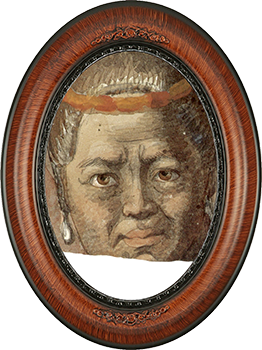 Ka'ahumanu by Choris |
The early Hawaiians had not lost the wanderlust they evinced after boarding the first foreign vessel brought to their shores by Captain Cook, hints of which Campbell's reports reveal, such as his comment about hula performances where “women display all their finery, particularly in European clothes, if they are so fortunate as to possess any." Kotzebue and Chamisso's journals of the Russian brig Rurick are most distinguished by the changes they reveal occurring in the Sandwich Islands even before Kamehameha died. Kotzebue, for example, made the following observation about the royal entourage:
The black frocks look very ludicrous on the naked body; add to this, that they seldom fit, being purchased of American ships, where the people are not always so tall and so robust as the chiefs of the Sandwich Islands. One of the ministers had the waist half way up his back; the coat had been buttoned with the greatest difficulty; he perspired in his tight state dress; his distress was very evident, but fashion would not suffer him to relive himself of this inconvenience.
While at Honolulu, Kotzebue invited John Young (who was by this time "old and infirm"), his wife and the leading ali'i to dine with him:
My guests had all dressed themselves in their best attire. I scarcely recognized Karimoku, who shone in the dress of an English pilot, with polished boots, and a cocked hat; but all his things were so tight, that he could scarcely move a limb, and the noon-day's heat threatened to stifle him in his costume. Not less proud, but equally distressed, the other ali'i moved in their European dresses; and we saw here, sailors, coxcombs, and Moravians, confusedly mixed together. They were in the most painful situation in their gala-dress, and put me in mind of dressed-up monkies. In comparison with this the dress of Kamehameha's ministers is preferrable, as it merely consisted of a frock. This mode has servived to individual to such a pitch, that some article of European dress has become a matter of necessity, even to the meanest individual; some wear only a shirt, another has trowsers, and a third parades in a waistcoat.
The naturalist, Chamisso, observed that many imported plants were growing alongside native plants, but the Native Hawaiians stuck mostly to their traditional diets with a few exceptions: tobacco, watermelons, "and fruit in general." Native Hawaiian tattoos had evolved from what earlier explorers had seen, they now included imported designs of "goats, muskets, even letters of the alphabet," as well as names as was mentioned earlier. "To please the Europeans,” Chamisso added, some Native women "suffer their hair to grow, and tie it up behind in a queue"; and "Every body has now a looking-glass, and a pipe-head tied round the neck in a European handkerchief." Unlike at the time of Campbell, some seven years earlier, chiefs in general, not just King Kamehameha, were drinking rum bartered from Americans. Though Kamehameha did not smoke, Kotzebue watched Ka'ahumanu smoking with two of the King's other wives "with evident pleasure" and continued to do so "half dizzy." Kotzebue felt that smoking was so fashionable in the Sandwich Islands that "young children smoke before they learn to walk." Despite these foreign influences, however, Chamisso concluded:
The Hawaiians have in general wisely remained faithful, both to their national costume, and to their mode of life. Their princes only dressed themselves in honour of us with the utmost neatness, in fine English clothes, and imitated our manners with much propriety. They are at other times always dressed in their native costume, and only their foreign guests are served in porcelain and silver.
... Their intercourse with the Europeans has not yet had any particular influence on the social order, arts and manners of these peoples.
The death of King Kamehameha on May 8, 1819 marked the end of early Hawai'i, and British influence on the islands.* Other, non-material influences were making inroads as well, but Kamehameha had managed to keep them at bay until the end, if we can believe Chamisso who had observed Kamehameha less than two years before his death, and said:
"He is noble-minded, and, with the instruction he receives from foreigners, remains still faithful to the spirit of his people, and to the customs of his ancestors." When the Russian brig Rurick had first arrived in the Sandwich Islands, Kamehameha had manned the shore with 400 Natives Hawaiians armed with muskets. The King was anticipating a fight because of an earlier incident involving the crew of another Russian vessel. Later, Kotzebue learned from a haole interpreter that the every watchful conqueror Kamehameha had chosen his son, Liholiho to succeed him "from political motives, that no revolution may arise after his death.”*² Kotzebue was no more impressed with the heir apparent, Liholiho, than Chamisso who called him "weak" and “dull-minded":
We entered a neat and small house, in which Liholiho, a tall, corpulent, and naked figure, was stretched out on his stomach, and just indolently raised his head to look at his guests; near him sat several naked soldiers armed with muskets, who guarded the monster; a handsome young native, with a tuft of red feathers, drove away flies from him, and from his interesting countenance and becoming behaviour, I should rather have taken him for the king's son... The dog of all dogs [note: a later, false translation for his name] at last rose very lazily, and gaped upon us with a stupid vacant countenance... I could not learn his age, as no account is kept of it. I guess it may be about twenty-two years, and am of opinion, that his enormous corpulency is occasioned by his constant lying on the ground.
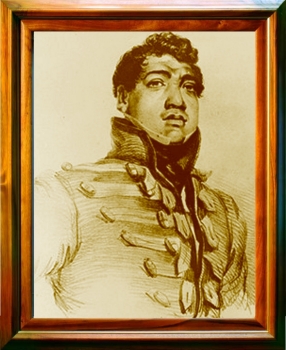 Liholiho or 'Iolani (Kamehameha II) |
Liholiho did indeed succeed his father as King of Hawai'i using the name Kamehameha II while Kamehameha's favorite wife, Ka'ahumanu, not Liholiho's mother, Keopuolani, served as kuhina nui, or regent.
* [Both Davis and Young were colonial Americans who had been born in Great Britain. Their allegiance to one or the other country is not what dictated the influence on Hawai'i, rather it was Kamehameha who chose which country to align with and it was clearly Britain, not the as yet nascent America.]
*² [In his journal of the adventures of the trading ship Maryland from 1805-1808, which included a stay in the Sandwich Islands from May to August, 1807, Isaac Iselin wrote: "Kamehameha is said to possess about two thousand muskets, twenty carriage or ship, guns, a ship, formerly the Leila Bird (an American), several large three masted schooners, besides small vessels of twenty to fifty tons."]
*² [In his journal of the adventures of the trading ship Maryland from 1805-1808, which included a stay in the Sandwich Islands from May to August, 1807, Isaac Iselin wrote: "Kamehameha is said to possess about two thousand muskets, twenty carriage or ship, guns, a ship, formerly the Leila Bird (an American), several large three masted schooners, besides small vessels of twenty to fifty tons."]
Borrowing liberally, I suspect, from a work published by Protestant missionary Hiram Bingham (see below) some twenty years before his own visit to the Kingdom of Hawai'i from 1866-67, Mark Twain, with his telltale sardonic humor, introduces us to the momentous changes which began shortly after Kamehameha's death:
While the first missionaries were on their way around the Horn, the idolatrous customs which had obtained in the island, as far back as tradition reached were suddenly broken up. Old Kamehameha I, was dead, and his son, Liholiho [or 'Iolani], the new King was a free liver, a roystering, dissolute fellow, and hated the restraints of the ancient kapu. His assistant in the Government, Ka'ahumanu, the Queen dowager, was proud and high-spirited, and hated the kapu because it restricted the privileges of her sex and degraded all women very nearly to the level of brutes. So the case stood. Liholiho had half a mind to put his foot down, Ka'ahumahu had a whole mind to badger him into doing it, and whiskey did the rest. It was probably the rest. It was probably the first time whiskey ever prominently figured as an aid to civilization. Liholiho came up to Kailua as drunk as a piper, and attended a great feast; the determined Queen spurred his drunken courage up to a reckless pitch, and then, while all the multitude stared in blank dismay, he moved deliberately forward and sat down with the women!
[From Mark Twain's Roughing It which was based in part on a four month sojourn in Hawai'i.]
[From Mark Twain's Roughing It which was based in part on a four month sojourn in Hawai'i.]
Kamehameha II's cousin and a chief on the island of Hawai'i, Kekuaokalani, led a battle against the new king's acquiescence to Ka'ahumanu's abandonment of the religion, but the insurrectionists soon gave up their fight after Kekuaokalani was killed. Momentous changes for the early Hawaiians had been ensured.